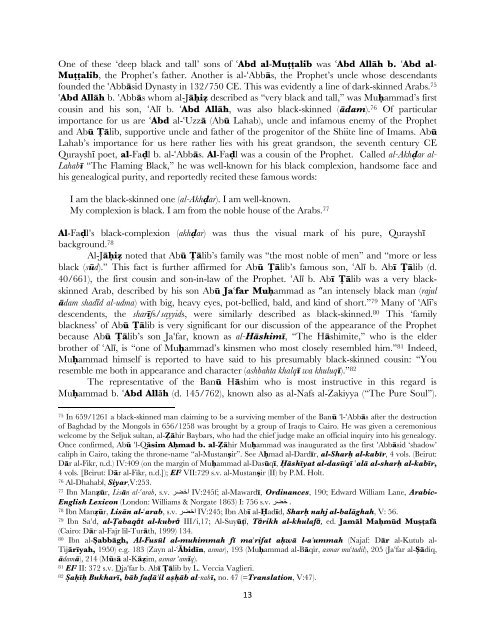Muhammad_Article.349.. - Dr. Wesley Muhammad
Muhammad_Article.349.. - Dr. Wesley Muhammad
Muhammad_Article.349.. - Dr. Wesley Muhammad
Create successful ePaper yourself
Turn your PDF publications into a flip-book with our unique Google optimized e-Paper software.
One of these ‘deep black and tall’ sons of #Abd al-Muããalib was #Abd All§h b. #Abd al-<br />
Muããalib, the Prophet’s father. Another is al-#Abb§s, the Prophet’s uncle whose descendants<br />
founded the #Abb§sid Dynasty in 132/750 CE. This was evidently a line of dark-skinned Arabs. 75<br />
#Abd All§h b. #Abb§s whom al-J§Èií described as “very black and tall,” was MuÈammad’s first<br />
cousin and his son, #Alī b. #Abd All§h, was also black-skinned (§dam). 76 Of particular<br />
importance for us are #Abd al-#Uzz§ (Abå Lahab), uncle and infamous enemy of the Prophet<br />
and Abå •§lib, supportive uncle and father of the progenitor of the Shiite line of Imams. Abå<br />
Lahab’s importance for us here rather lies with his great grandson, the seventh century CE<br />
Qurayshī poet, al-Fa∙l b. al-#Abb§s. Al-Fa∙l was a cousin of the Prophet. Called al-Akh∙ar al-<br />
LahabÊ “The Flaming Black,” he was well-known for his black complexion, handsome face and<br />
his genealogical purity, and reportedly recited these famous words:<br />
I am the black-skinned one (al-Akh∙ar). I am well-known.<br />
My complexion is black. I am from the noble house of the Arabs. 77<br />
Al-Fa∙l’s black-complexion (akh∙ar) was thus the visual mark of his pure, Qurayshī<br />
background. 78<br />
Al-J§Èií noted that Abå •§lib’s family was “the most noble of men” and “more or less<br />
black (såd).” This fact is further affirmed for Abå •§lib’s famous son, #Alī b. AbÊ •§lib (d.<br />
40/661), the first cousin and son-in-law of the Prophet. #Alī b. AbÊ •§lib was a very blackskinned<br />
Arab, described by his son Abå Ja#far MuÈammad as “an intensely black man (rajul<br />
§dam shadīd al-udma) with big, heavy eyes, pot-bellied, bald, and kind of short.” 79 Many of #Alī’s<br />
descendents, the sharÊfs/sayyids, were similarly described as black-skinned. 80 This ‘family<br />
blackness’ of Abå •§lib is very significant for our discussion of the appearance of the Prophet<br />
because Abå •§lib’s son Ja#far, known as al-H§shimÊ, “The H§shimite,” who is the elder<br />
brother of #Alī, is “one of MuÈammad’s kinsmen who most closely resembled him.” 81 Indeed,<br />
MuÈammad himself is reported to have said to his presumably black-skinned cousin: “You<br />
resemble me both in appearance and character (ashbahta khalqÊ wa khuluqÊ).” 82<br />
The representative of the Banå H§shim who is most instructive in this regard is<br />
MuÈammad b. #Abd Allāh (d. 145/762), known also as al-Nafs al-Zakiyya (“The Pure Soul”).<br />
75 In 659/1261 a black-skinned man claiming to be a surviving member of the Banå "l-#Abb§s after the destruction<br />
of Baghdad by the Mongols in 656/1258 was brought by a group of Iraqis to Cairo. He was given a ceremonious<br />
welcome by the Seljuk sultan, al-£§hir Baybars, who had the chief judge make an official inquiry into his genealogy.<br />
Once confirmed, Abå "l-Q§sim AÈmad b. al-£§hir MuÈammad was inaugurated as the first #Abb§sid ‘shadow’<br />
caliph in Cairo, taking the throne-name “al-Mustanßir”. See AÈmad al-DardÊr, al-SharÈ al-kabÊr, 4 vols. (Beirut:<br />
D§r al-Fikr, n.d.) IV:409 (on the margin of MuÈammad al-DasåqÊ, \§shÊyat al-dasåqÊ #al§ al-sharÈ al-kabÊr,<br />
4 vols. [Beirut: D§r al-Fikr, n.d.]); EI 2 VII:729 s.v. al-Mustanßir (II) by P.M. Holt.<br />
76 Al-Dhahabī, Siyar,V:253.<br />
77 Ibn Maníår, Lis§n al-#arab, s.v. رضخا IV:245f; al-MawardÊ, Ordinances, 190; Edward William Lane, Arabic-<br />
English Lexicon (London: Williams & Norgate 1863) I: 756 s.v. رضخ .<br />
78 Ibn Maníår, Lis§n al-#arab, s.v. رضخا IV:245; Ibn AbÊ al-\adÊd, SharÈ nahj al-bal§ghah, V: 56.<br />
79 Ibn Sa#d, al-•abaqāt al-kubrā III/i,17; Al-Suyåãī, Tārikh al-khulafā, ed. Jam§l MaÈmåd Mußãaf§<br />
(Cairo: D§r al-Fajr lil-Tur§th, 1999) 134.<br />
80 Ibn al-‘abb§gh, Al-Fusål al-muhimmah fÊ ma#rifat aÈw§ l-a"ummah (Najaf: D§r al-Kutub al-<br />
Tij§rÊyah, 1950) e.g. 183 (Zayn al-#$bidÊn, asmar), 193 (MuÈammad al-B§qir, asmar mu#tadil), 205 (Ja#far al-‘§diq,<br />
§dam§), 214 (Mås§ al-K§íim, asmar #amÊq).<br />
81 EI 2 II: 372 s.v. Dja#far b. AbÊ •§lib by L. Veccia Vaglieri.<br />
82 ‘aÈÊÈ BukharÊ, b§b fa∙§"il aßȧb al-nabÊ, no. 47 (=Translation, V:47).<br />
13

















